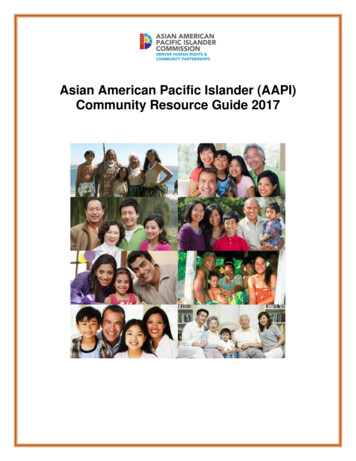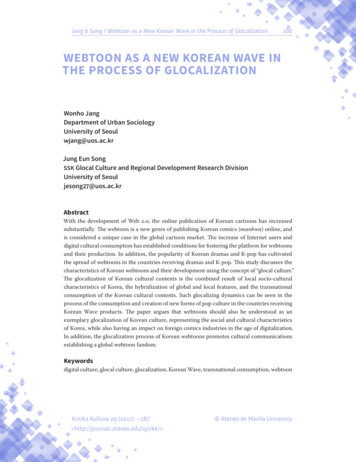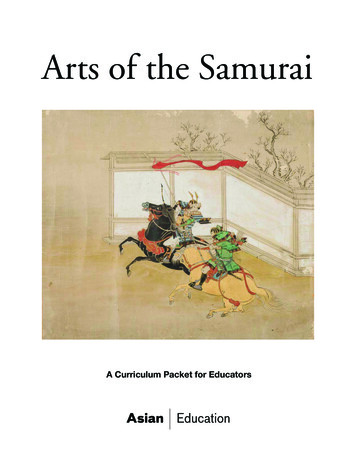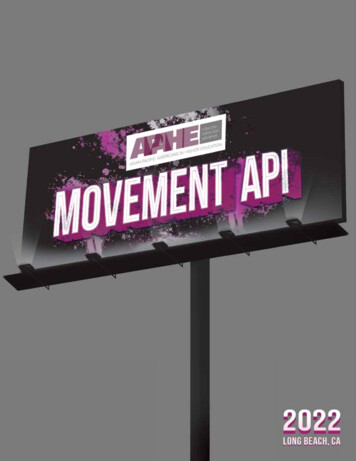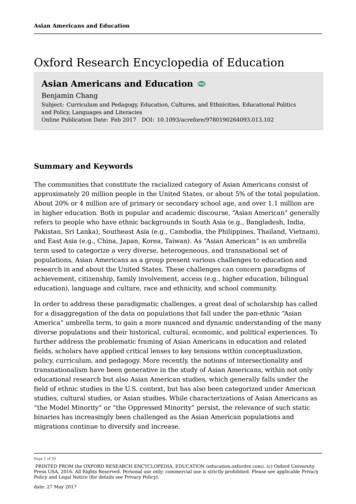
Transcription
STATE OF NEBRASKAATTESTATION REVIEWOF THEASIAN COMMUNITY AND CULTURAL CENTERJULY 1, 2007 THROUGH JUNE 30, 2010This document is an official public record of the State of Nebraska, issued bythe Auditor of Public Accounts.Modification of this document may change the accuracy of the original documentand may be prohibited by law.Issued on November 1, 2010
ASIAN COMMUNITY AND CULTURAL CENTERATTESTATION REVIEWTABLE OF CONTENTSSectionsPageIndependent Accountant’s Report1-2Background3-5Criteria5Summary of Procedures5-6Summary of Results6 - 16Overall Conclusion16 - 17Exhibit A – Board President’s Letter December 2009Exhibit B – Alleged Fraudulent Payments to VendorsExhibit C – Alleged Fraudulent Reimbursements to the Executive DirectorExhibit D – Manipulated Vendor InvoiceExhibit E – Executive Director Emails to HBEExhibit F – Questionable ExpensesExhibit G – Summary of Payments to The Peacock Indian Cuisine, Inc.Exhibit H – CFDA #93.576 Questioned Costs
Independent Accountant’s ReportCitizens of the State of Nebraska:We have reviewed the financial activity of the Asian Community and Cultural Center for theperiod July 1, 2007, through June 30, 2010. The Asian Community and Cultural Center’smanagement is responsible for the financial activity. We did not obtain a written assertionregarding such matters from management.Our review was conducted in accordance with attestation standards established by the AmericanInstitute of Certified Public Accountants and the standards applicable to attestation engagementscontained in Government Auditing Standards issued by the Comptroller General of the UnitedStates. A review is substantially less in scope than an examination, the objective of which is theexpression of an opinion on the financial activity. Accordingly, we do not express such anopinion.Based on our review, the items noted in the Summary of Results section of the report came toour attention that caused us to believe that the financial activity was not presented, in all materialrespects, in conformity with the criteria set forth in the Criteria section.In accordance with Government Auditing Standards, we are required to report findings ofdeficiencies in internal control, violations of provisions of contracts or grant agreements, andabuse that are material to the Asian Community and Cultural Center’s financial activity and anyfraud and illegal acts that are more than inconsequential that come to our attention during ourreview. We are also required to obtain the views of management on those matters. We did notperform our review for the purpose of expressing an opinion on the internal control over theAsian Community and Cultural Center’s financial activity or on compliance and other matters;accordingly, we express no such opinions.-1-
Our review disclosed certain findings that are required to be reported under GovernmentAuditing Standards and certain other matters. Those findings, along with the views ofmanagement and the identification of material weaknesses and significant deficiencies, aredescribed below in the Summary of Results. A deficiency in internal control exists when thedesign or operation of a control does not allow management or employees, in the normal courseof performing their assigned functions, to prevent or detect misstatements on a timely basis. Amaterial weakness is a deficiency or combination of deficiencies in internal control, such thatthere is a reasonable possibility that a material misstatement of the subject matter will not beprevented, or detected and corrected on a timely basis. A significant deficiency is a deficiency,or a combination of deficiencies, in internal control that is less severe than a material weakness,yet important enough to merit attention by those charged with governance.This report is intended solely for the information and use of the Citizens of the State ofNebraska, management of the Asian Community and Cultural Center, others within the AsianCommunity and Cultural Center, and the appropriate Federal and regulatory agencies. Althoughit should not be used by anyone other than these specified parties, this report is a matter of publicrecord, and its distribution is not limited.Signed Original on FileMike FoleyAuditor of Public AccountsMary AverySpecial Audits and Finance ManagerNovember 1, 2010-2-
ASIAN COMMUNITY AND CULTURAL CENTERATTESTATION REVIEWBackgroundThe Asian Community and Cultural Center (ACCC) was founded in 1994 and is supportedthrough grants and donations from both individuals and organizations and through Federal, State,and local funding sources. The ACCC is an independent non-profit, 501(c)(3) organization,whose mission is “To support and empower Asian people while sharing our cultures with theentire community through our programs and services.” The ACCC is governed by a Board ofDirectors (BOD). The Auditor of Public Accounts (APA) identified the following key staffduring our review of the ACCC: Robert Suarez – Board PresidentAn Sampson – Board TreasurerModesta Putla – Executive Director (January 2004 – January 2010)Maureen Brase-Houchin – Interim Executive DirectorJason Varga – Associate DirectorIn August 2009, the Board President began an annual performance evaluation of the ExecutiveDirector. According to the Board President, he was unable to locate prior documentedevaluations, and the Executive Director refused to give him access to her personnel file. Duringthe performance evaluation, it was determined the Executive Director had full control andauthority over all the ACCC finances. Several financial irregularities were noted that caused theBoard President to send a letter, in December 2009, to the ACCC BOD highlighting theirregularities related to the Executive Director’s activities. See Exhibit A. The irregularitiesincluded, but were not limited to, unauthorized salary increases, excessive mileagereimbursements, unauthorized vacation payouts, and significant payments to The Peacock IndianCuisine, Inc. (The Peacock). The Peacock is a private restaurant entity owned by the ExecutiveDirector and Samuel Rajakumar, her husband. An emergency BOD executive committeemeeting was held to discuss the issues. On January 6, 2010, the Executive Director waspermitted to resign pending BOD action in response to the Board President’s December 2009letter.Following an emergency meeting, the BOD consulted with its accounting firm and, in themonths that followed, the BOD met many more times. The BOD directed its accounting firm toreview the ACCC accounting procedures and to obtain documentation to support an internalinvestigation of the allegations contained in the December 2009 letter. The BOD also consultedwith the ACCC’s private auditor, later determining the auditor had failed to conduct previousaudits in the manner anticipated. The BOD considered hiring a private firm to conduct aforensic audit; however, it was decided the ACCC could not afford a full forensic audit by aprivate accounting firm. The BOD retained counsel and requested assistance from the LincolnPolice Department (LPD), meeting with an LPD investigator on three separate occasions. At theconclusion of those meetings, the ACCC was informed the LPD does not conduct audits, and itwas suggested the ACCC contact the Lancaster County Attorney’s office for further assistance.The BOD then contacted the Lancaster County Board of Commissioners and the APA for help indetermining the extent of any suspected fraud. During this period, the BOD also revised theACCC procedures to limit the authority of the Executive Director and tighten the BOD’soversight over the ACCC finances.-3-
ASIAN COMMUNITY AND CULTURAL CENTERATTESTATION REVIEWOn May 13, 2010, the Board President requested that the Lancaster County Board ofCommissioners ask the APA to perform a review of the financial activity of the ACCC for thepast three years. On June 15, 2010, the Lancaster County Board sent a letter asking the APA toperform an attestation review of the books of the ACCC. The APA agreed to perform anattestation review for the period July 1, 2007, through June 30, 2010. The APA held an entrancemeeting with the ACCC Board President, Treasurer, and Interim Executive Director on July 9,2010.During the three-year period tested, in addition to grants, the ACCC received money fromprivate donors, as well as fees for the various programs and resources the center provided to orsponsored for the community, such as youth and senior programs, language classes, andeducational and community events. Money was received at the ACCC by walk-ins, mail, andthrough a PayPal account set up for online donations. The ACCC employees were to complete apre-numbered, carbon-copied receipt for all money received. One copy was given to the payerand one was attached to the deposit. The mail was opened daily and incoming money wasrecorded in an Access database documenting the date received, sender, receiver, type ofpayment, and amount. The daily cash and checks received were given to the Executive Directorfor coding in the accounting system and to create the deposit. The Executive Director wouldthen make the deposit at the bank.The ACCC contracted with HBE Becker Meyer Love LLP (HBE) to provide limited accountingfunctions. HBE utilized QuickBooks software for the accounting of the ACCC. HBE recordedthe ACCC’s daily transactions, which included, but was not limited to, issuing checks, recordingdeposits, and reconciling the bank activity. All accounting documentation was submitted by theACCC’s Executive Director to HBE to be recorded in the system. For the issuance of checks,the ACCC’s Executive Director submitted check request forms to HBE every two weeks (seeExhibit D for an example of a check request form) and HBE would print the checks and sendthem back to the ACCC’s Executive Director to sign and mail. Checks over 500 were requiredto be signed by two ACCC representatives.The ACCC was last audited by Dana F. Cole & Company, LLP for calendar years 2007 and2008; no findings were noted in the resulting audit report. Due to the failure of Dana F. Cole &Company, LLP to advise the BOD of the ACCC’s problematic accounting procedures, the BODdecided to terminate its relationship with that auditing firm; hence, no audit was performed in2009.The bank activity for the ACCC business checking account was summarized and evaluated bythe APA. The following is a brief summary of the activity and balances for the period July 1,2007, through June 30, 2010:-4-
ASIAN COMMUNITY AND CULTURAL CENTERATTESTATION REVIEWTime PeriodJuly 2007 through December 2007January 2008 through December 2008January 2009 through December 2009January 2010 through June 2010Total Bank Activity for PeriodWithdrawals/Deposits/CreditsDebits 241,784.64 229,651.18 379,594.04 361,662.28 379,196.04 388,700.05 149,705.62 162,857.21 1,150,280.34 1,142,870.72Period EndingBankBalances 34,458.70 52,390.46 42,886.45 29,734.86The ACCC had additional bank accounts related to savings and certificates of deposit. Thebalances of those accounts at June 30, 2010, were as follows:BankWest Gate Bank CDCornhusker Bank CDUnion Bank Savings AccountEnding Balanceon June 2010Statement 11,223.07 15,329.05 4,848.45CriteriaThe criteria used in this attestation review were Federal regulations, the ACCC EmployeeHandbook, good internal controls, and good business practices.Summary of ProceduresPursuant to Neb. Rev. Stat. § 84-304 (Reissue 2008), the APA conducted an attestation review ofthe ACCC’s financial activity for July 1, 2007, through June 30, 2010, in accordance withstandards applicable to attestation engagements contained in Government Auditing Standardsissued by the Comptroller General of the United States.The APA’s attestation review consisted of the following procedures: Obtained and documented an understanding of the ACCC’s operations. Obtained the ACCC’s bank statements and a copy of the QuickBooks file from HBE forJuly 1, 2007, through June 30, 2010.o Reconciled the QuickBooks financial records to the bank statements.o Analyzed the bank statements for any discrepancies.-5-
ASIAN COMMUNITY AND CULTURAL CENTERATTESTATION REVIEW Accumulated and summarized all payments, including expense reimbursements, made tothe Executive Director. Tested receipts received by the ACCC, as recorded on the Access database, and traced tothe deposits within the bank statements. Tested payments made from the ACCC, including check and credit card payments. Summarized all payments to related parties, including The Peacock. Obtained grant agreements for the period tested and summarized all questioned costsrelated to Federal grants received. Referred information documenting alleged fraudulent payments to the Nebraska AttorneyGeneral’s office, as advised by the Lancaster County Attorney’s office. An exit conference was held on October 19, 2010, to discuss the results of this attestationreview. Those in attendance from the ACCC were:Robert Suarez, Board PresidentAndrew Wedeman, Board Vice PresidentMaureen Brase-Houchin, Interim Executive DirectorSummary of ResultsThe summary of our attestation review noted the following findings and recommendations:1.Alleged Fraudulent PaymentsThe APA was requested to look into financial irregularities at the ACCC for the period July 1,2007, through June 30, 2010. At the request of the APA, the ACCC provided all bankstatements and supporting documentation for the period under review. The APA accumulated 15,599 in transactions, which appear to have been fraudulent. A brief summary is noted below:Alleged Fraudulent PaymentsPayments Related to Payroll for the ExecutiveDirectorExpense Reimbursement Payments to theExecutive DirectorPayments to VendorsTotal Alleged Fraud Amount10,630.84 2,676.36 2,292.2515,599.45Payments Related to Payroll for the Executive Director The APA noted three payroll-related payments, totalling 10,257.84, made to theExecutive Director that were neither authorized in accordance with the ACCC’sEmployee Handbook nor supported by adequate documentation. Two payments were forvacation payouts, and one was a retroactive payment for a 4% pay increase. Theseappear to be fraudulent payments.-6-
ASIAN COMMUNITY AND CULTURAL CENTERATTESTATION REVIEW On November 25, 2009, the Executive Director requested a check, payable to her,for the payout of four weeks of vacation. A similar request for four weeks ofvacation was also made during 2008. According to the ACCC’s EmployeeHandbook, pay-in-lieu of vacation is only allowed when an employee is laid off,discharged, or resigns with due notice. Additionally, the Employee Handbookstates vacation accruals are not cumulative from year to year. See Exhibit D. TheExecutive Director would not have had four weeks of unused vacation in either2008 or 2009, as she would only have earned 15 days during 2008 and 16 daysduring 2009. The ACCC did not have procedures in place to track accruals andusage of vacation or sick leave to ensure individuals had leave available for use.On November 13, 2009, the Executive Director sent an email to HBE, stating shewas to receive a 4% raise starting in August 2009, and would like a retroactivecheck for that amount. However, according to both the documented performanceevaluation and discussions with the Board President, the Executive Director was notauthorized to receive a raise in 2009.See Exhibit E for copies of emails sent to HBE.As noted above, on November 13, 2009, the Executive Director requested a retroactivepayment for a 4% raise that had not been authorized by the BOD. There were four paychecks between November 2009, when the payment for retroactive pay occurred, and herresignation in January 2010. The 4% raise increased her gross pay by 93.25 eachperiod, resulting in an unauthorized raise and alleged fraudulent payment for four payperiods in the amount of 373.The alleged fraudulent payments regarding payroll are summarized below:CheckDateCheck #NameMemo10/29/20086202Putla, Modesta A.4 weeksvacation pay11/13/20097021Putla, Modesta A.11/25/20097052Putla, Modesta A.11/27/2009703512/11/2009Amount* 4,662.30 746.00 4,849.54Putla, Modesta A. 93.257063Putla, Modesta A. 93.2512/25/20097085Putla, Modesta A. 93.251/08/20107111Putla, Modesta A. 93.254 weeksvacation payTotal 10,630.84Note *: These are gross amounts prior to withholdings.-7-ExplanationPayout of four weeks unused vacationfor 2008.Payout of four percent retroactiveincrease from August 2009 throughNovember 2009.Payout of four weeks unused vacationfor 2009.Only the 4% portion is wrong, entiregross pay on check was 2,424.40.Only the 4% portion is wrong, entiregross pay on check was 2,424.40.Only the 4% portion is wrong, entiregross pay on check was 2,424.40.Only the 4% portion is wrong, entiregross pay on check was 2,424.40.
ASIAN COMMUNITY AND CULTURAL CENTERATTESTATION REVIEWExpense Reimbursement Payments to the Executive DirectorThe APA noted several expense reimbursements to the Executive Director for which nosupporting documentation was attached and, therefore, appear to have been improper andpossibly fraudulent. Several of the reimbursements were for staff mileage; however, nodocumentation was on file to support those expenses. The Board President and Board Treasurertold the APA that the Executive Director did not drive and did not even have a driver’s license.However, the Executive Director had a valid Nebraska driver’s license, which was issued onSeptember 14, 2009, and the Nebraska Department of Motor Vehicles (DMV) indicated theExecutive Director had a previous Louisiana driver’s license issued March 15, 2004. Accordingto the ACCC staff and DMV, the Executive Director and her family had only one vehicle. The APA noted 2,143.69 for mileage reimbursements that had no documentary support.Moreover, the mileage claimed appears excessive. The Executive Director was claimingreimbursement for mileage driven; however, according to both the Board President andBoard Treasurer, she did not drive. The reimbursements lacked documentation for thevehicle used, location to and from, or any other information to support the mileage orreimbursement and, as a result, appear fraudulent. See Exhibit C. The APA also noted a reimbursement of 532.67 for the purchase of special orderwindow coverings from JCPenney. The ACCC did not have the window coveringsduring our review. ACCC staff contacted JCPenney during our review and determinedthe window coverings were actually shipped to the address of The Peacock. This appearsto be a fraudulent reimbursement. See Exhibit C. The total of the questioned reimbursements identified above is 2,676.36. See Exhibit Cfor itemized information and details.Payments to VendorsThe APA noted 11 allegedly fraudulent ACCC payments, totalling 2,292.25, to vendors madeby the Executive Director for personal use. Several of the check requests did not havesupporting documentation attached; therefore, the APA and the ACCC staff requested detailsfrom the vendors. The following allegedly fraudulent payments were noted during testing. One check request for 250 to Williamson Honda noted the payment was for clientassistance with car repairs. It was paid by ACCC through a Building Strong Familiesgrant; however, there was no support attached to the payment. The ACCC staff obtainedsupporting information for the payment directly from Williamson Honda. The invoicewas for repairs to a 2003 Honda Accord owned by Samuel Rajakumar and the ExecutiveDirector. The check for 250 only covered a portion of the total invoice. One payment for 210.95 to a local clinic was for expenses related to the ExecutiveDirector’s family. The invoice attached to the check request had the billing name andpatient removed; however, the APA contacted the vendor and obtained an original copyof the invoice billable to Samuel Rajakumar with the Executive Director’s home address.See Exhibit D for a copy of the manipulated invoice. Further payments of a similar nature were noted during testing, such as payments toLincoln Electric System for the Executive Director’s home residence utilities andpayments for a cell phone owned by the Executive Director’s husband. See Exhibit B for a summary of all related payments.-8-
ASIAN COMMUNITY AND CULTURAL CENTERATTESTATION REVIEWBased on the lack of controls over the ACCC’s financial records and activities, the APA believesthat additional suspect expenses are likely. The Executive Director had complete control of allfinancial activities, including receiving monies due to the ACCC. As a result, we consider thisfinding to be a material weakness.We recommend the ACCC implement policies and procedures toensure adequate controls are put in place to prevent future suspectaccounting activity. The controls should include a separateindependent review of all payments made from the ACCC toensure such payments are properly supported and reasonable. TheBOD should approve all payments made on behalf of the ACCC.This information was referred to the Nebraska Attorney General’soffice for any action deemed appropriate.2.Lack of Adequate Internal Controls and Written Policies and ProceduresGood internal controls require a proper segregation of duties to ensure no one individual is in theposition both to perpetrate and to conceal errors or irregularities. Adequate internal controlsinclude monitoring by the BOD and other individuals within the ACCC to ensure policies andprocedures are functioning as intended.The ACCC lacked adequate controls for incoming revenues and outgoing expenses, as follows: The Executive Director had complete control over the ACCC’s finances, including thedepositing of incoming money, requesting and authorizing expenditures, such as vendorpayments, salary increases, vacation payouts, and serving as the sole contact with theACCC’s accountants. The BOD did not properly monitor the activities performed by theExecutive Director or other ACCC employees. The BOD was provided with a monthlyoverview of the budget position of the ACCC; however, it did not require the ExecutiveDirector to provide a detailed listing of the ACCC’s expenditures. The BOD hadestablished no formal policies or procedures for governing the ACCC, with the exceptionof the largely inadequate Employee Handbook. The Executive Director and/or the Associate Director were the main check signors andauthorized signatories for checks. The Associate Director informed the APA that hewould sign checks the Executive Director asked him to sign without any directknowledge of why the payment was being made. The APA noted instances of both theExecutive Director and the Associate Director signing their own reimbursement checksunder 500. Furthermore, it appears the ACCC was creating invoices on behalf ofindividuals they were paying. Three invoices, all dated August 22, 2008, were in thesame format, with only the payee name and description being different. According to the ACCC staff, a receipt for incoming money was not always issued, and alisting of the receipt numbers was not maintained to account properly for all moniesreceived. If a receipt was voided, it was not maintained; therefore, there was no way toverify all monies received were deposited. Receipts were not sequential. Additionally,the ACCC staff maintained an Access database of incoming money received; however, it-9-
ASIAN COMMUNITY AND CULTURAL CENTERATTESTATION REVIEW was not always completed for the daily receipts, and there were no procedures establishedfor a separate individual to compare the database and the receipt booklet to the depositmade at the bank to ensure all monies received were properly deposited.The ACCC also had an online PayPal account through which individuals couldelectronically remit donations to the entity. The money received in the PayPal accounthad to be periodically transferred to the ACCC’s business account. The ExecutiveDirector and Associate Director were the only individuals with access to the account, andthere were no restrictions on the transfers out of the account. Therefore, it was necessaryto have procedures for an independent review of the account to ensure all money receivedwas properly transferred to the ACCC’s bank account. There were no improper transfersnoted during the period tested. However, we noted money was not transferred from thePayPal account to the ACCC’s account timely. The first PayPal account deposit was inApril 2008; however, the first transfer was not made to the ACCC’s account untilMay 15, 2009, for 500. A second transfer was made on June 3, 2009, for 256.84, andthe last transfer out of the account was performed on June 8, 2010, for 884.53.There was a lack of controls over the fixed assets of the ACCC. The APA obtained acurrent listing of the ACCC’s fixed assets; however, items recently purchased by theACCC were not on the listing. The APA noted a projector purchased on August 24,2008, for 1,264.89 and a DVD player purchased on September 30, 2008, for 320.99were not on the asset listing. Furthermore, three decorative wall hangings noted on thelisting were not at the ACCC. According to the ACCC staff, the Executive Director tookthe wall hangings after she resigned; the ACCC staff were unsure whether the ExecutiveDirector had personally paid for the items.The ACCC purchased gift cards to give to speakers at sponsored events. According tostaff, gift cards were kept by the employee who purchased them until distributed to therecipients. The ACCC employees kept little, if any, record of who received the cards. Inaddition, there are no policies regarding when gift cards should be purchased or who iseligible to receive them.Without adequate internal controls and written policies and procedures to ensure ACCC fundsare properly accounted for, there is a significant risk for fraud or errors to occur and remainundetected. When receipts are not recorded properly, and one individual is able to perform allprocesses of a transaction, there is a significant risk for loss or misuse of funds. We consider thisfinding to be a material weakness.We recommend the ACCC implement policies and procedures tostrengthen the internal controls of the entity to ensure that no oneindividual is in the position both to perpetrate and to conceal errorsor irregularities. The BOD should take an active role in the dailyoperations of the ACCC, including the review of detailedpayments. Furthermore, we recommend the following: Individuals authorizing payments should ensure all theACCC expenditures are both properly supported andreasonable.Additionally, employees should not beauthorized to approve their own reimbursements.- 10 -
ASIAN COMMUNITY AND CULTURAL CENTERATTESTATION REVIEW 3.A listing of all money received and receipts issued shouldbe maintained and reconciled to the deposit to ensure allmoney received is properly deposited. The reconciliationshould be completed by someone other than the individualsopening the mail and completing the deposit slip.The ACCC’s PayPal account should be reviewedperiodically by someone other than those authorized tomake transfers, thereby ensuring that money received wasproperly transferred to the ACCC’s business account.Furthermore, transfers to the ACCC’s account should beperformed monthly.The ACCC should maintain adequate documentation ofassets purchased and periodically ensure assets are on hand.The ACCC should implement policies and proceduresregarding the purchase, possession, and distribution of giftcards, including a signed document stating the recipientreceived the gift card distributed.Questionable Expenses of the ACCCThe APA tested several transactions related to staff expense reimbursements, payments madewith the ACCC’s business credit card, and payments to vendors for the period July 1, 2007,through June 30, 2010. A significant number of expenses had little or no documentation tosupport the payment.The following findings were noted during testing: For 15 of 22 payments tested, the expense did not appear reasonable, or there was nodocumentation to support the payment. This totalled 12,617.65.o One of the payments tested was to the Associate Director for reimbursement oftechnical and event supplies. The 2,000 check was paid on August 20, 2008;however, all expenses related to the reimbursement were dated after August 20,and all of the receipts remitted totalled only 1,985.64. According to the ACCCstaff, check requests took approximately two weeks to process; therefore, theACCC would issue checks to employees in advance.o See Exhibit F for details on the findings noted. In addition to the allegedly fraudulent expense reimbursements made to the ExecutiveDirector, as noted in Comment Number 1, the APA tested an additional 21reimbursements, totalling 4,228.01. These all appear to entail some unreasonable andunnecessary reimbursements, and they all lacked adequate supporting documentation.See Exhibit F for details on the findings noted. The expense reimbursements includedcab rides, meals, travel expenses, and supplies. During testing of the payments made with the ACCC’s credit cards and debit cards, wenoted 5 of 12 payments tested did not appear reasonable and necessary. They totalled 948.00.- 11 -
ASIAN COMMUNITY AND CULTURAL CENTERATTESTATION REVIEWo One payment, for the purchase of gas gift cards totalling 150, did not havedocumentation to support the recipients of the cards. At the time of ourfieldwork, the staff of the ACCC did not recall having or distributing gas giftcards; however, some gas gift cards have been subsequently located.o One payment tested was for the purchase of a charcoal grill and accessories for 68 from Lowe’s in August 2007, for an event held by the ACCC. According tothe Associate Director, the grill was located at his house; however, he said it wasold and in bad shape.o See Exhibit F for details on the findings noted.When adequate supporting documentation is not on file, there is a significant risk fo
functions. HBE utilized QuickBooks software for the accounting of the ACCC. HBE recorded the ACCC's daily transactions, which included, but was not limited to, issuing checks, recording deposits, and reconciling the bank activity. All accounting documentation was submitted by the ACCC's Executive Director to HBE to be recorded in the system.
